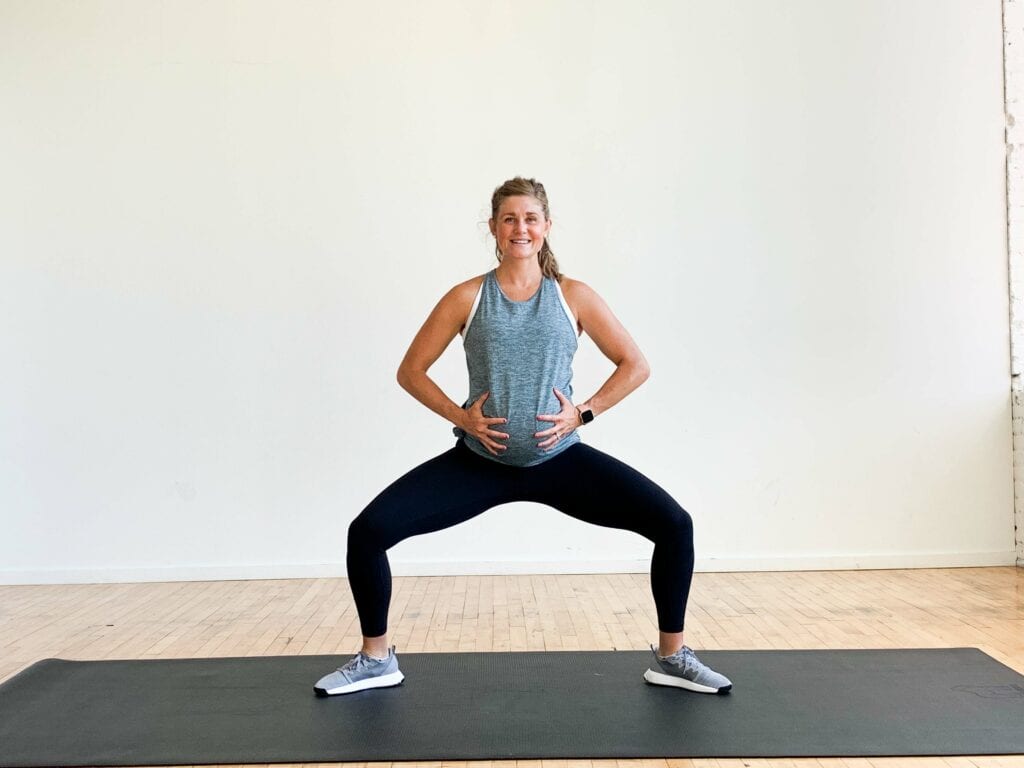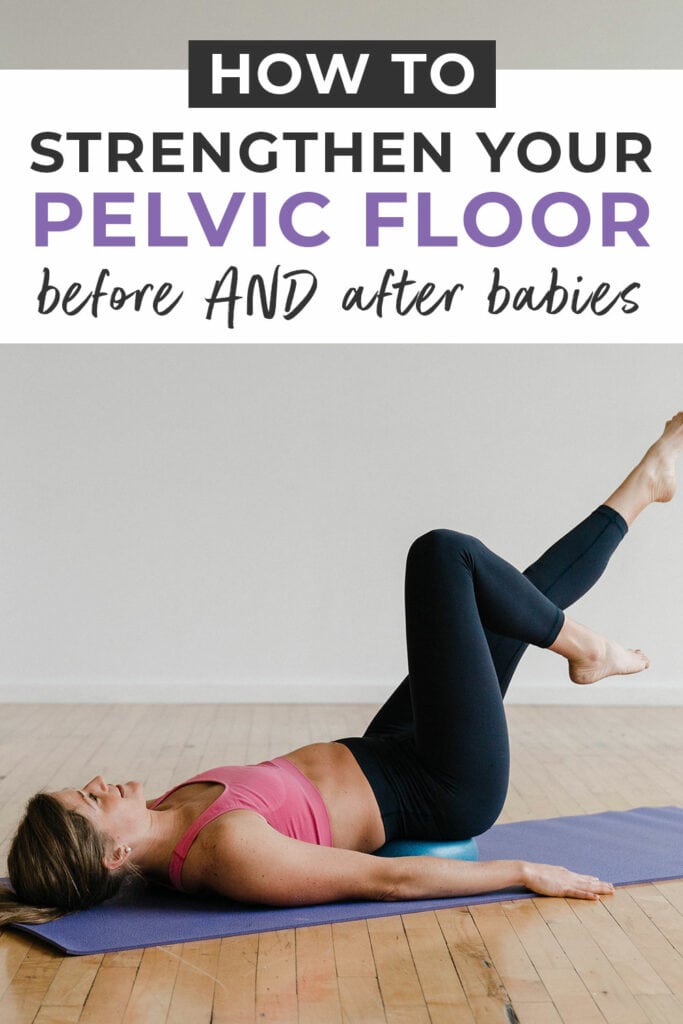

10 Things You Need to Know About Your Pelvic Floor (interview with a pelvic floor physical therapist)
You’ve heard of kegels, but pelvic floor physical therapy covers SO much more than that. We’re answering your top 10 FAQs about pelvic floor health, including the best pelvic floor exercises before and after baby, how to deal with incontinence, and postpartum recovery.
Video created in partnership with Dr. Jennifer Joslyn PT, DPT, SFMA of Motion.
*If you’re having trouble seeing this video, try turning off or pausing your ad-blocker. If you prefer, you can also view this video on Pelvic Floor Health + Pelvic Floor Exercises on YouTube here. While you’re there, SUBSCRIBE to our YouTube channel to get all the newest workouts!
PSA: pelvic floor health is important for ALL women, whether you’ve had babies or not.
My personal pelvic floor physical therapy experience was so educational that I thought…ALL women need to know this stuff.
As a certified personal trainer and fitness instructor I feel like I know my body pretty well. Yet, I had so many questions about ‘what was going on down there,’ after having my babies.
If I had these questions, other women must too…
So I sat down with my pelvic floor physical therapist (hi, Dr. Jenn of Motion) to answer YOUR top 10 questions about pelvic floor health and pelvic floor physical therapy!

FAQs with a Pelvic Floor Physical Therapist: 10 Things You Need to Know About Your Pelvic Floor
You can watch the full video interview on identifying your pelvic floor muscles and strengthening your pelvic floor muscles at the top of this post, or we’ve outlined the answers to each question in greater detail below.
My TOP 3 TAKE-AWAY’S from this interview that I’ve implemented during pelvic floor exercises:
- Imagine there is a string between your hip bones and as you exhale that string (or your TA muscles) are pulling your hip bones together.
You can see this demonstrated in the video around the 12:50 mark. You can also reference question #9 for more information on the best exercises to heal diastatis recti. - When performing kegels imagine you are picking up a blueberry with your vagina.
You can learn more about this around the 5:50 mark in the video. You can also reference question #5 for more information on how to properly do kegel exercises. - Avoid any exercises that cause doming or coning of your core muscles. This doesn’t mean you won’t ever be able to perform that exercise, it just may mean that you do not currently have the strength for that particular movement. It could also mean that you may need to switch up your strategy for performing that exercise.
You can learn more about this around the 10:38 mark in the video. You can also reference question #8 for more information on pelvic floor relaxation.
I practice these three take aways during these core and ab workouts:
- 10-Minute Beginner Ab Workout
- 7 Exercises for Postpartum Core Recovery and Diastasis Recti
- 10-Minute Lower Ab Workout
And I was surprised to learn that pelvic floor muscle relaxation is just as important, if not more important, than strengthening your pelvic floor muscles.

Q1: Who should see a pelvic floor physical therapist? How do I know if I have a pelvic floor issue? (video mark: :32)
Your pelvic floor muscles sit at the bottom of your pelvis like a sling. They help with the support and function of your bladder, uterus, and rectum.
Pelvic floor dysfunction symptoms a pelvic floor therapist commonly treats are:
- Urinary or fecal incontinence (stress incontinence)
- Pelvic organ prolapse
- Constipation/diarrhea
- Diastasis recti
- Pain with intercourse
- Scar pain
- Pain related to the pelvis, low back, and hips
You may need to see a pelvic floor physical therapist if you are:
- Leaking
- Having pelvic pain
- Having low back pain
- Having hip pain
- Noticing core weakness
- Feeling pressure/heaviness in your pelvic floor
Pelvic floor physical therapy (PT) is appropriate if you are pregnant, postpartum, or if you’ve never had a baby! Anyone can experience issues with their pelvic floor.
For more information on pelvic health at Motion, click here.
Q2: What is pelvic floor physical therapy? What does an intro pelvic floor therapy appointment look like? (video mark: 1:50)
A pelvic floor physical therapist is a physical therapist who specializes in pelvic floor health and conditions related to your pelvic floor muscles.
Oftentimes, pelvic floor PTs have undergone extensive continuing education and mentoring to gain the confidence and expert competence to treat these conditions.
The first appointment often entails:
- An extensive subjective history to learn as much as we can about the symptoms you are experiencing. We ask questions about the function of your bladder, uterus, and rectum and how specific daily activities impact your symptoms.
- We also ask about your birth history, past medical conditions, what you do for work, and how you like to exercise. We may also ask about your diet, how much water or other fluids you drink, and how often you use the bathroom. This allows us to tailor your plan of care based on your current lifestyle and goals.
- Depending on your history, I will often perform a two part exam (vaginal or rectal) — external and internal. Pelvic floor physical therapy does not require an internal exam, however, it does allow us to gather a lot of information.
That being said, we completely respect your comfort level and can perform an assessment completely externally if needed. During the exam, we assess your breathing pattern, sensation of the internal and external structures related to your pelvic floor (is anything painful, tight, numb, tingling?), strength, coordination, and endurance of your pelvic floor muscles.
We also test for pelvic organ prolapse. If you are postpartum, we will check for diastasis recti and/or take a look at your c-section scar. Additionally, we assess your overall movement patterns and may screen your back and/or hips to better understand your condition(s).
From there, we come together to make up a game plan as to how we will treat your symptoms and work toward your goals. For some people, this just may mean one or two sessions, while others may need a bit more. Everyone is totally unique!
You can see more about what an intro session looks like on this segment with Twin Cities Live.

Q3: How do I know if I have a tight pelvic floor or loose pelvic floor? (video mark: 4:00)
To truly learn, it is best to have a formal PT assessment as everyone presents a bit differently.
However, it is common that people with tight pelvic floors often experience:
- Pelvic pain
- Feel like they cannot completely empty their bladder or bowels
- Constipation
- Have pain with intercourse
- May experience incontinence
Those with weak or “loose” pelvic floors often experience:
- Leaking with coughing, sneezing, laughing or feel like they cannot make it to the bathroom on time
- May feel pressure or heaviness in their pelvic floor. Might have a feeling like something is “stuck” or that their pelvic organs are “falling out” with certain activities
- Feel like they cannot control when they pass gas or when they need to have a bowel movement
A common misconception is that pelvic floor PT is just kegels, but it is totally possible that a person can be leaking urine and have a tight pelvic floor.
If you are having symptoms, it is best to have a formal assessment of your pelvic floor muscles to learn which exercises are appropriate for you!
Q4: Is it too late to recover and strengthen my pelvic floor? 1+ years PP? (video mark: 5:30)
Definitely not. I treat adults of ALL ages!
You are considered “postpartum” regardless if it has been 6 weeks or 16 years since you’ve had a baby.

Q5: How to stop incontinence? What are the best exercises to stop peeing my pants? (video mark 5:50)
It depends on the reason why the incontinence is occurring.
Sometimes, we are placing too much stress on our core and pelvic floor with dynamic activities like jumping, squatting, and lifting your baby.
This can occur when you do not manage pressure well between your diaphragm (muscle right underneath your rib cage), core, and pelvic floor. If we hold our breath and bear down (push through our pelvic floor) during these activities, leaking can occur.
I always cue people to “exhale on exertion” or breathe out during the hard part of an exercise. For example, you should breathe out as you lift you baby, as you come up from a squat, and as your feet hit the floor when you jump.
If your pelvic floor is too tight, learning to relax and let go of your pelvic floor is super helpful. Spend some time in a comfortable position breathing and visualizing your pelvic floor relaxing, lengthening, and melting underneath you. Check in throughout the day to make sure you are not clenching these muscles.
If you think your pelvic floor is lengthened and weak, I would start strengthening with kegels. Inhale and allow your pelvic floor and belly to relax and expand, exhale and imagine you are picking up a blueberry with your vagina. You can practice using a mirror at home to ensure your muscles are lifting up and away from the mirror as you perform your kegel.
Q6: How can I strengthen my pelvic floor BEFORE having babies? (video mark 7:50)
I would recommend incorporating your pelvic floor muscles into your daily activities or workouts.
As I previously stated, during the hard part of the exercise, you will exhale and lightly contract your core and pelvic floor muscles.
Remember, being able to relax your pelvic floor is just as important as strengthening. Spend a little time performing kegels a few days a week focusing on relaxing your core and pelvic floor as you inhale and contracting your core and pelvic floor as you exhale.

Q7: How can I strengthen my pelvic floor AFTER having babies vaginally? How can I strengthen my pelvic floor after a C-Section? (video mark 9:00)
I would highly recommend checking in with a physical therapist postpartum.
Regardless if you delivered vaginally or via C-section, it is great to have a formal assessment to get an idea of your strength. Additionally, we can help to assess your core muscles for diastasis recti, check for pelvic organ prolapse, and examine scar tissue from perineal tearing or c-section.
If you do not have access to a pelvic floor PT, I would recommend starting with pelvic floor relaxation to reduce any pain you may be having.
Then, slowly start to incorporate kegels once when you start to feel more comfortable. For some people, this may be right away, for others, this may take a couple of weeks.
Q8: What’s the best exercise to recover your pelvic floor postpartum? (video mark 10:38)
Pelvic floor muscle relaxation with diaphragmatic breathing.
This taps into your vagus nerve and helps your entire body and mind to relax. You can practice this several times a day.
Q9: Diastasis Recti: What exercises should I AVOID if I have Diastasis Recti? What are the best exercises to heal Diastasis Recti? (video mark 11:55 and video demo of exercise at 12:50)
Avoid any exercise that causes you to see doming or coning of your core muscles.
This doesn’t mean you won’t ever be able to perform that exercise, it just may mean that you do not currently have the strength or you may need to improve your strategy for performing that particular movement.
One thing you can experiment with is managing your pressure system (exhaling during the hard part of the exercise) and properly engaging your transverse abdominis muscles (see below). Sometimes, this is all it takes to be able to perform the exercise optimally without coming or doming.
I always start with learning how to engage your transverse abdominis:
- Lay on your back with your knees bent and feet flat.
- Find your hip bones and move your fingers one inch inwards.
- Do a little fake cough. Those are your transverse abdominis muscles.
- To engage them, inhale and allow your core and pelvic floor to relax. Imagine there is a string between your hip bones and as you exhale that string (or your TA muscles) are pulling your hip bones together.
If you need an example of how to do TA breathing, check out the video (approximately from 0:15 to 1:50) in this post: The 5 Best Exercises for Pregnancy.
This is the most foundational exercise to learn and I always progress from there. You can slowly perform this by adding movement in your arms or legs, changing up the positioning, or adding dynamic exercises like jumping or running.
If you don’t have access to a pelvic floor physical therapist you can learn more about How To Check For Diastasis Recti At Home in this post.
Q10: What is the number one thing you think ALL women need to know about their pelvic floor? (video mark 15:15)
Do not hesitate to ask for help!
The most common misconception is that pelvic floor issues like leaking while you cough, sneeze, or laugh or feeling like you will never be able to run again is totally normal. Not true!
With guidance and practice, we as pelvic floor physical therapists try our best to help you reach your goals no matter what those are.

A big thank you to Dr. Jennifer Joslyn PT, DPT, SFMA of Motion for sharing her knowledge and expertise with us on pelvic floor health. If you’re local to the Twin Cities area I highly suggest seeing Dr. Jennifer Joslyn PT, DPT, SFMA of Motion.
This post on pelvic floor health is a part of our Q + A series where we answer your top 10 questions about a different topic each month. You might also enjoy our posts on:
Pin this Post: 10 Things to Know About Pelvic Floor Physical Therapy























